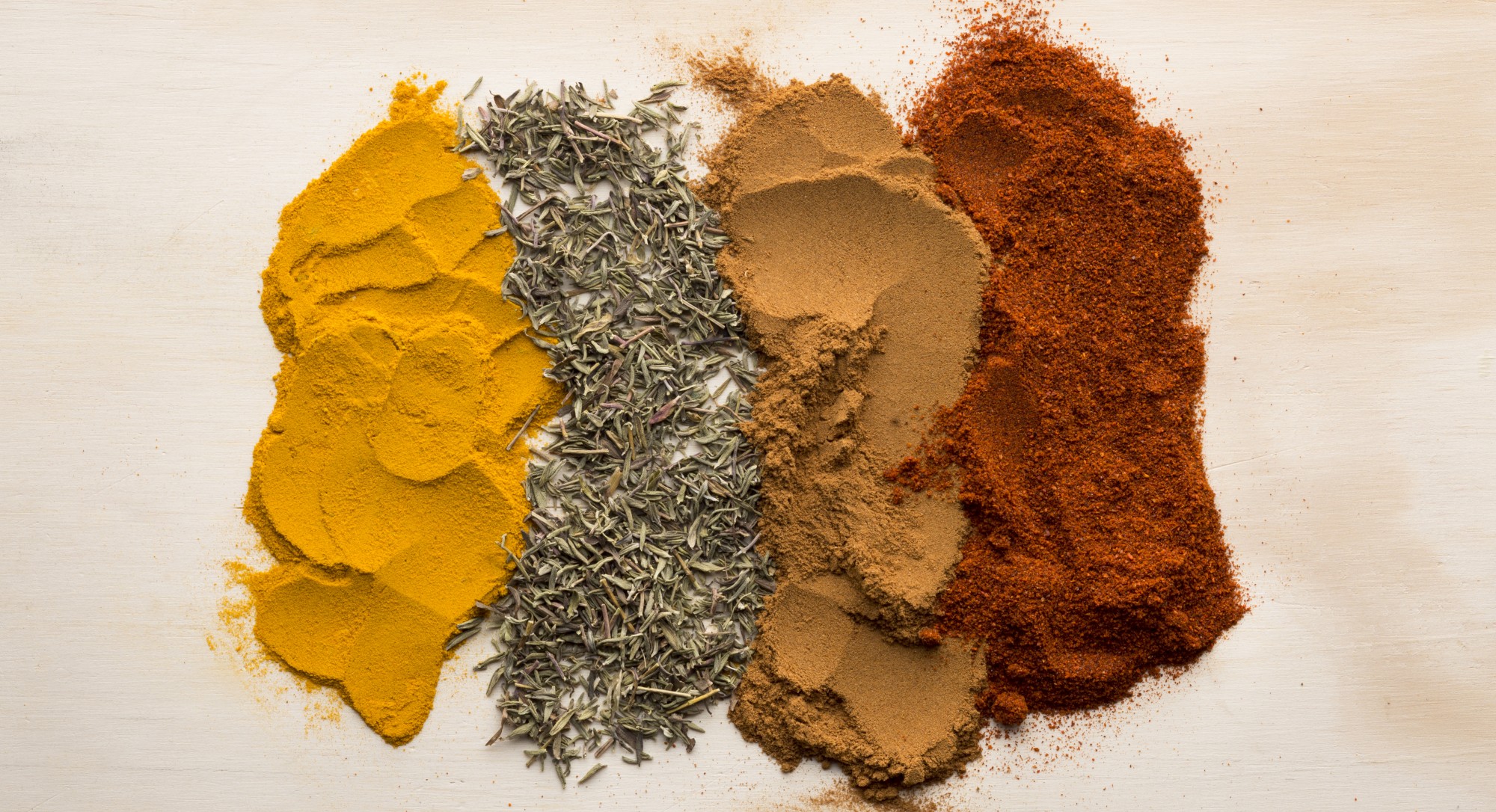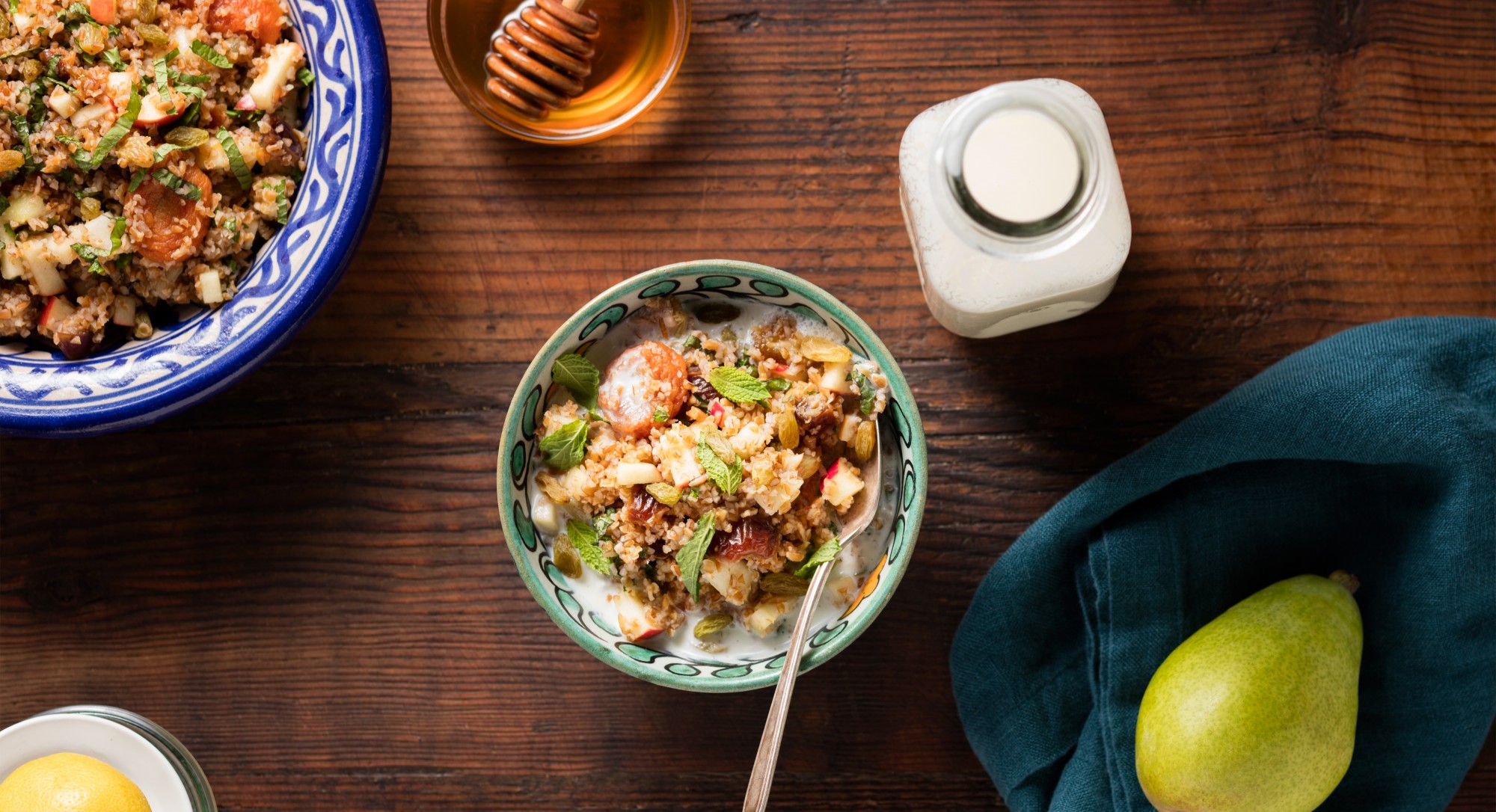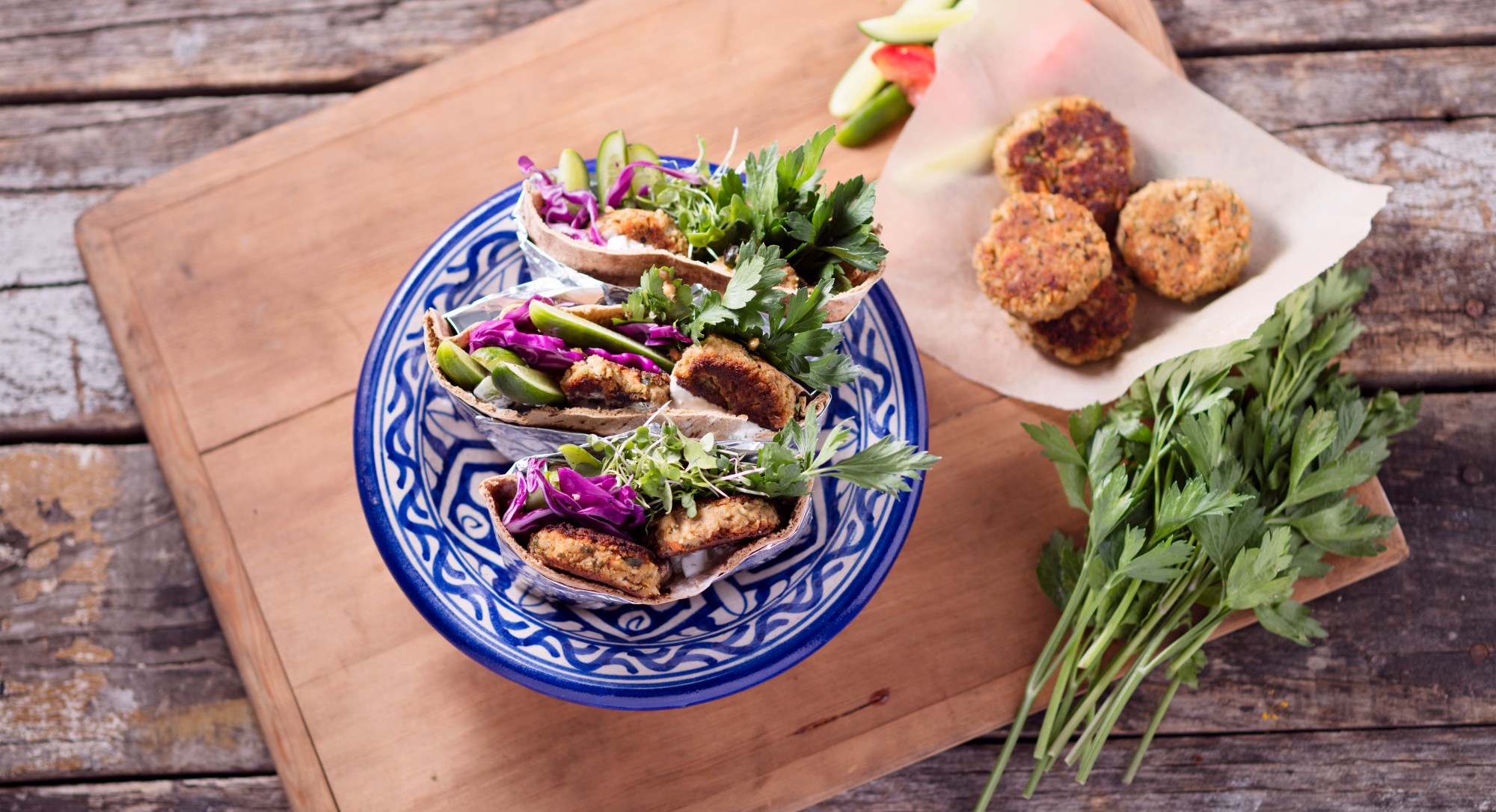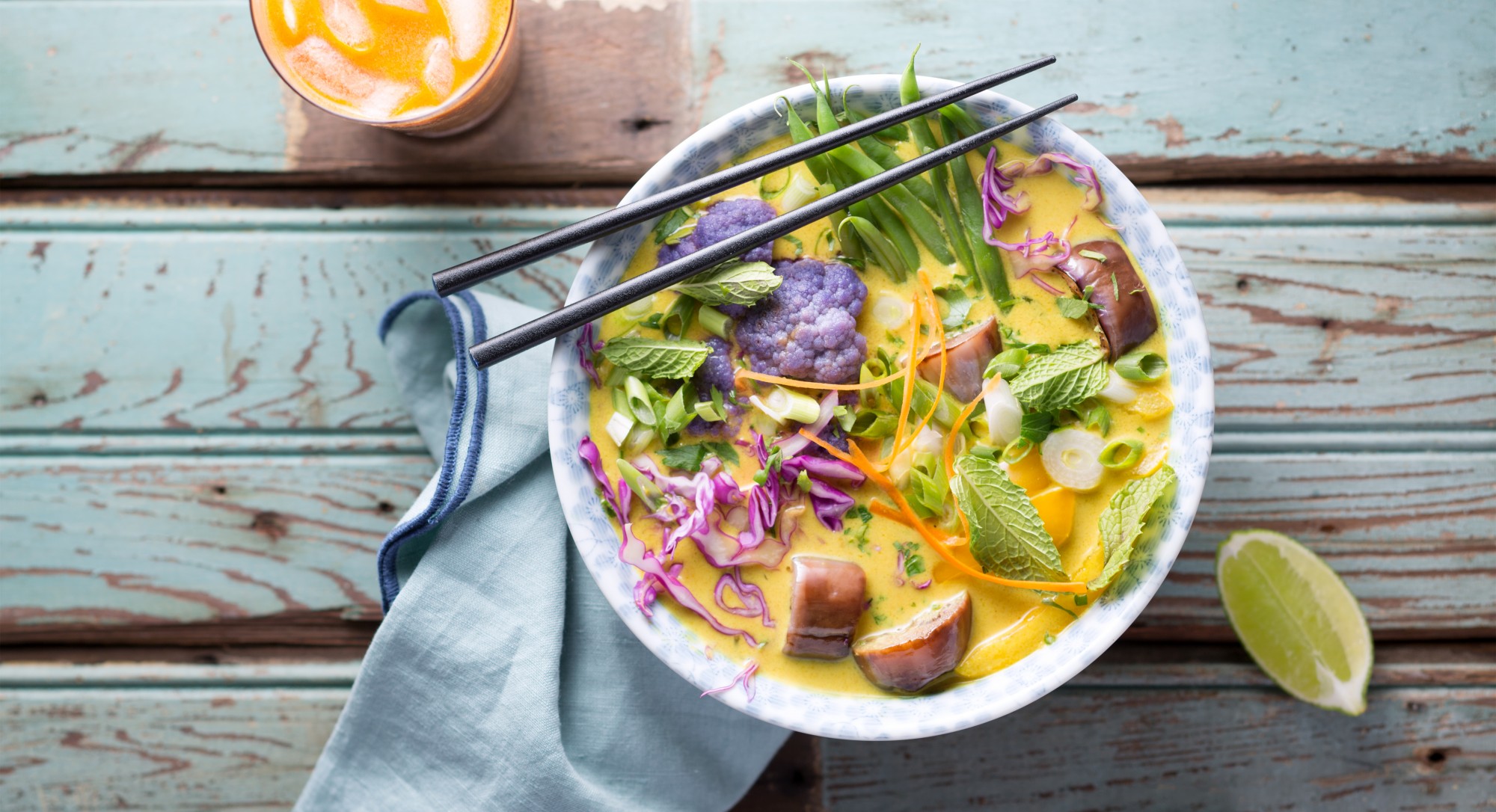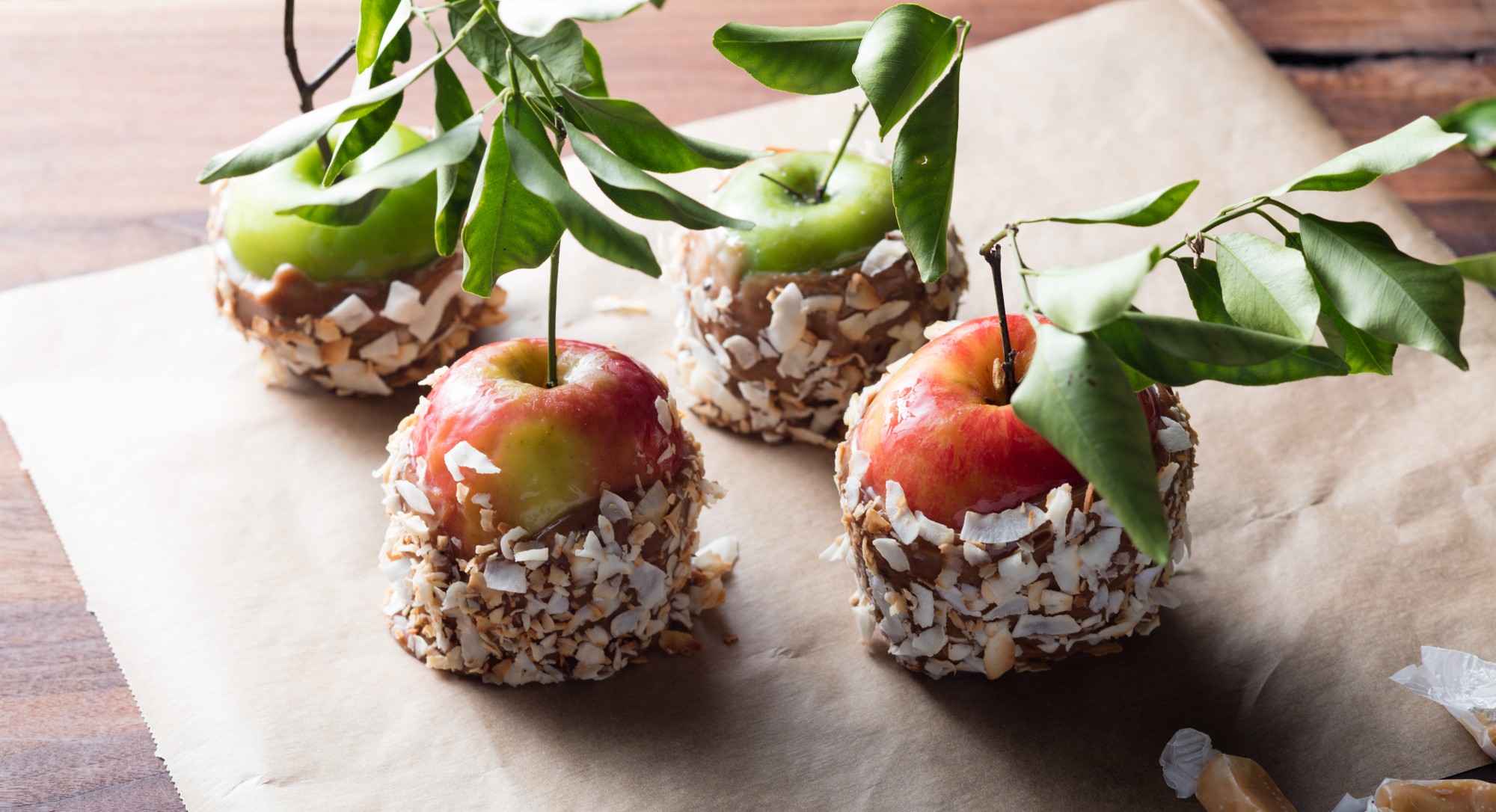Healthy Meals on a Budget: Tips, Tricks, and 66 Recipes
Publish Date: January 14, 2016
Last Update: October 22, 2025
Some might recall the ramen noodle diet of their college days as a cheap and quick way to stay fueled through all-nighters and exams. But was it healthy? Not so much. But the terms “healthy” and “budget” don’t have to be mutually exclusive.
Consistently eating well without breaking the bank just takes smart shopping, meal planning, and an arsenal of nutritious recipes. That’s where we come in. With our hacks and recipes, you’ll be eating better—for less—in no time.
13 tips for healthy eating on a budget
1. Hit the farmers market
It doesn’t get any more “farm fresh” than your local farmers market—the best place to shop for whole foods. Typically you’ll find organic and heirloom produce harvested at the peak of their flavor and nutrition, and hormone-free meat, dairy, and eggs—directly from growers and producers. Shopping straight from the source saves money and supports small family farms. Now that’s sustainability all around.
2. Shop perishables at wholesale prices
To supplement fresh foods from the farmers market, Thrive Market has all the organic, non-GMO pantry staples, snacks, and condiments you need to curate a healthy life for you and yours—and everything is 25 to 50 percent off retail prices.
3. Eat in as much as possible
Home is where the health is! Cooking at home is probably one of the top things you can do to trim the fat from your food budget. Restaurant and fast-food meals really add up, and they’re often high in sugar and unhealthy fats. At home, you’ll always know exactly what’s in your food.
4. Plan ahead
If you map out your meals for the week ahead, you give yourself an edge in staying healthy and being aware of your budget. You’re thinking about ingredients, shopping specifically, and keeping yourself on track for eating smart rather than succumbing to the instant gratification of fast foods and snacks.
5. Make a grocery list (and stick to it)
Before shopping, make a list of everything you need and follow it to a T. This intentional tunnel vision will prevent impulse buys and keep you focused on making healthy choices. Also, don’t shop on an empty stomach. Greasy potato chips can look mighty good when you’re starving.
6. Head straight to the produce section
As soon as you get to the store, make a beeline for the produce section to load up on the most nutritious items first. Then shop the perimeter, where whole foods like dairy, eggs, meat and fish, and fresh herbs are usually stocked. You might find you don’t even need to spend time aimlessly perusing the middle aisles, which are often a danger-zone filled with processed foods. (And remember, you can get any healthy perishable item you need on the cheap from Thrive Market!)
7. Change with the seasons
Buy seasonal produce whenever possible. In-season fruits and veggies are more flavorful, nutritious, and affordable (because they’re more abundant). And when unusual fruits, vegetables, and herbs—like pluots—pop up at the farmers market or produce section, you just might be inspired to expand your horizons, adding nutritional and flavor variety into your diet.
8. Buy double-duty foods
Stock up on foods that can play multiple roles in meals. For example, plain or Greek yogurt works as breakfast and as a condiment—swap out sour cream for it and reap the probiotic benefits of better gut health. And olive oil can be used for healthy cooking as well as a homemade salad dressing base.
9. Consider veggies and fruits your MVPs
Vegetables and fruits are the most valuable players in any kitchen. Just think of the tomato—perfect as a salad or sandwich topper, but also an ideal base in some of our favorite comfort foods like soup and spaghetti. In fact, all kinds of veggies can be pureed to create some insanely flavorful sauces, from tart to sweet to savory.
Or, blend a smoothie from any melange of fruits and veggies—instant, drinkable vitamins and minerals.
And let’s be real—meat is expensive. Consuming it in small amounts can still be satisfying. Treating lean meat as a side and veggies as the main goes a long way in saving you cash. You can even pack your plate with as many vegetable dishes as you can conjure up in one sitting—variety is the spice of life, right?
10. Freeze!
Anything you want to save for later—foods that might go bad, school lunches for the week ahead, leftovers—just freeze it. This will help cut back on wasted food and save time during the week.
One cool trick to try is to pour little portions of pasta sauce into ice cube trays—plop those babies on top of pasta in a container and it’ll melt by lunch time.
Freezing farmers market produce can also preserve it at the peak of its flavor and nutrition.
11. Make your own broth
Save your residuals from meat and vegetables like bones, onion tops, carrot tops, even wilted veggies, and brew your own batch of broth. It’s easy:
- Store leftover pieces in the freezer until you’ve got a few cups.
- Once you do, just add water, boil, and simmer on low heat for a few hours.
- For vegetable broth, use olive oil, coarsely chopped onion, carrot, crushed garlic cloves, thyme, bay leaf, and peppercorns.
- For chicken or beef broth, just add chicken or beef bones to the recipe above.
You’ve managed to make the most of what would’ve been tossed in the trash, and you’ve got an excellent cooking base to work with.
12. Throw everything but the kitchen sink in a pot
Vegetable-rich one-pot meals save you time and supply tons of healthy leftovers, which you can always freeze.
13. Keep portions in check
Americans are notorious for heaping plates of food. Limit yourself to reasonable portions—here’s a visual guide to what moderate servings actually look like. In the long run, portion control will help you maintain a healthy weight and save tons of money. One of the easiest tricks is to use smaller plates. Adopt this attitude when you eat out, too—those loaded appetizers and main dishes are perfectly shareable. And you don’t have to eat them all in one sitting—take some home for later.
Healthy meals shopping list
When you think of pantry staples, a few everyday ingredients may come to mind: sugar, flour, vegetable oil, white rice, to name a few. Unfortunately, when consumed regularly, these foods can be precursors to health problems including diabetes, hypertension, heart disease, and obesity. Fortunately, upgrading your pantry is simpler and cheaper than you think.
The basics
Here are 10 new basics to embrace into your daily diet.
- Whole-grain brown rice: No, you don’t have to give up rice, but whenever possible, cook the whole-grain brown variety rather than white. It has more natural fiber, nutrients, and vitamins, including iron, zinc, thiamin, niacin, magnesium, and B-6. While white rice is a high-glycemic food, brown rice is low-glycemic, meaning it doesn’t increase blood sugar as much or as quickly.
- Quinoa: Wanna take it a step further? Experiment with quinoa, a whole grain with a lot of protein. First-timers may find the texture unusual, but there are a few different kinds, and you may just find one that floats your boat.
- Lentils: These legumes are a hearty and healthy protein alternative to meat, and they’re super cheap, too. Grab a bag of organic sprouted green lentils rich in vitamins, micronutrients, and digestive enzymes and make a nutritious stew or soup. In a pinch? Organic canned lentils do the trick; just rinse them thoroughly.
- Black beans: Also loaded with fiber and protein, black beans really fill you up. They’re low in sodium and have a hearty dose of potassium, calcium, and magnesium, all of which help to regulate blood pressure. A great addition to any soup, beans of any kind pair well with brown rice and quinoa. Rinse canned beans thoroughly before eating.
- Extra virgin olive oil: Toss the vegetable oil and get into EVOO. It’ll not only elevate your cooking with distinct flavor, but also add beneficial fatty acids and antioxidants that can reduce inflammation and promote overall everyday health. It’s multi-purpose, too—aside from sautéing with EVOO, you can drizzle it on many savory dishes and salads for extra flavor.
- Apple cider vinegar: Some people hail ACV as a kind of magical potion that fixes everything from high blood sugar to digestive issues to acne. It really is a versatile ingredient to keep around the house—drink it as a shooter to give your digestive system a jolt, whisk it into a tangy salad dressing, or use it to preserve foods. Studies also show that fermented foods like ACV can be good for mental health.
- Sea salt: Replace ordinary table salt with the more flavorful sea salt. Made by evaporating salt water from the ocean, it has an amazing mineral content due to its minimal processing. Table salt, on the other hand, is usually mined from the earth and processed heavily to remove minerals. Sea salt’s concentrated flavor means you can use a lot less of it, and in turn, lower your sodium intake. To make up for iodine, you can opt for the iodized kind.
- Turmeric: You don’t need a ton of salt to flavor food. Open up flavor possibilities by experimenting with herbs and spices. Consider turmeric, which has tons of benefits. A staple in curry dishes, the bright-orange spice is anti-inflammatory, can reduce the risk of heart attacks, and delay the onset of diabetes in prediabetic people. Not to mention its potent flavor goes a long way in jazzing up any dish.
- Raw sugar: Ditch refined white sugar, which has been linked to obesity and diabetes, and instead sweeten with raw sugar, a less-processed variety. But, use it sparingly—it is still sugar. An even healthier alternative would be raw honey, although it’s a bit of a splurge.
- Seaweed: Wanna get really adventurous? Stock up on sea vegetable products like dried seaweed or kelp noodles, which add a savory umami flavor—that fifth basic taste you might have heard about—to meals. They’re highly nutritious, too—high in iodine, which promotes thyroid and hormone health.
Essential herbs and spices
Stock up on these essential dried herbs and spices to always have tons of flavor at your fingertips. They may seem like a splurge up front, but they’ll last a long time.
- Black peppercorns
- Garlic powder
- Onion powder
- Basil
- Oregano
- Rosemary
- Bay leaves
- Thyme
- Cumin
- Allspice
- Cayenne pepper
- Paprika
- Cinnamon
Budget-friendly healthy meal recipes
Shopping is half the battle, but cooking is another story. To make it easier, we’ve compiled 66 of our best recipes for healthy meals on a budget. We even threw in some picks especially for kids. And for those who are trying to lose a little weight, there are lots of low-carb and low-calorie (but high-flavor!) options, too.
Breakfast
- Green Smoothie Bowl: Try your own version of a veggie- and fruit-packed smoothie bowl featuring green goodies like kale, spinach, and avocado. It’s a perfect recipe for two.
- Homemade Gluten-Free Cherry Pop-Tarts: Never worry about trans fats or loads of added sugar from processed toaster tarts. A homemade version of this breakfast-to-go is the best swap.
- Carrot Cake Baked Oatmeal: No joke, it really tastes like carrot cake, and it’s gluten-free.
- Coconut Flour Pancakes: For a healthified, Paleo-friendly, and gluten-free breakfast for two, try pancakes made with coconut flour.
- Apple Pie Overnight Oats: The most decadent bowl of oatmeal that tastes like apple pie. Yes, please!
- Fruity Bulgur Wheat Porridge: For a more delicate version of oatmeal, try a slightly sweet, fruity porridge. A great breakfast for a family of six.
Lunch
- Fig and Goat Cheese Pasta: A light vegetarian meal that’s also gluten-free, thanks to quinoa pasta.
- Kabocha Squash Soup: A simple, yet elegant pureed fall soup that serves six.
- Kelp Noodle Jap Chae: Try your hand at a Korean noodle stir-fry that’s vegan, gluten-free, and Paleo-friendly.
- Chickpea Patties: Falafel sandwiches and plates are easy to make at home with this recipe for chickpea patties.
- Dairy-Free Tomato-Chickpea Soup: Sub in chickpeas to make a creamy, vegan-friendly tomato soup. Dinner’s on for six!
- Yogi Lentil Bowl: A lentil bowl is midday meal perfection—so simple, yet energizing and satisfying (addictive, even!).
- Chicken Laab: It’s not as intimidating as it sounds. With flavors similar to Thai, our healthy take on a Laotian staple comes together in less than 15 minutes.
- Grilled Goat Cheese Egg-in-a-Hole: More like a brunch dish, this egg-in-a-hole presentation transforms an already fancy grilled cheese into a showstopper.
- Tuna Hand Rolls: Yup, homemade sushi is within reach, and it’s pretty simple and affordable.
Dinner
- Yellow Curry with Rainbow Vegetables: The most vibrant bowl of curry you ever did see, packed with a veritable rainbow of veggies.
- Lentil-Parsnip Shepherd’s Pie: We turned a classic comfort food into a healthier vegan dish for six.
- Poached Cod: Tomato sauce makes a great base for perfectly flaky and flavorful poached cod.
- Mustard Roast Beef: An impressive Sunday supper made easy.
- Orange-Cayenne Tofu Bowl: A citrusy tofu bowl is a truly yummy option for “Meatless Monday.”
- Beef and Broccolini Stir-Fry: Try a healthified version of a Chinese takeout stand-by.
- Lomo Saltado: A traditional Peruvian dinner for two that’s bold, spicy, and easy to make.
- Mushroom and Poached Egg Spaghetti: A poached egg elevates a simple pasta dish.
- Bibimbap: Here the classic garlicky Korean dish is made vegetarian, Paleo, and gluten-free. The perfect serving for two.
- Beef Pho: The quickest, simplest homemade pho recipe.
- Thai Red Curry Salmon Bowl with Kelp Noodles: A lightened-up, low-carb version of red curry.
- Tahini Chicken: Give roasted chicken a makeover with this Middle Eastern–inspired recipe.
- Cedar Planked Salmon with Grilled Vegetable Kabobs: Heat up the grill and make a simple seafood-and-vegetable meal that’s nutritious and satisfying.
Sides
- Parsnip Fries: Skip fried potatoes and instead opt for these crispy, Paleo-friendly fries.
- Fried Okra: Nope, deep-fried foods are not off limits on a healthy diet—not with gluten-free batter and a healthy fat like coconut oil.
- Roasted Japanese Eggplant With Turmeric Yogurt Sauce: A light and yummy veggie side dish.
- Broccolini Salad: Hold the mayo and sugar—a light and tangy vinaigrette makes a lovely dressing for broccolini.
- Coconut Creamed Spinach: Coconut oil and coconut milk makes a vegan and Paleo-friendly meal out of creamed spinach.
- Sautéed Rainbow Chard: Who says greens have to be green? Rainbow chard makes a colorful veggie side dish. Apple cider vinegar adds an irresistible tanginess.
Snacks
- Salt and Vinegar Brussels Sprouts Chips: An unexpected ingredient mimics the taste and texture of a beloved snack.
- Coconut Sriracha Kale Chips: Making the perfect kale chips at home couldn’t be easier.
- Raw Thumbprint Cookies: You won’t even notice that these jam-filled cookies are raw and gluten-free.
- Marinated Green Olives: Amp up olives with an herb and spice marinade.
- Slow-Roasted Tomato Salsa: With tomatoes, garlic, lemon, and olive oil, fresh salsa can actually be a tasty vehicle for lots of nutrients.
- Pumpkin Hummus: An autumnal hummus recipe that works as a dip or as part of an earthy vegetable lunch bowl.
- Cauliflower Hummus: Instead of chickpeas, cauliflower acts as a base for Paleo-friendly hummus.
- Red Pepper Walnut Dip: Fans of Mediterranean or Middle Eastern cuisine know this as muhammara, a super flavorful dip.
- Honey-Almond Popcorn Balls: Honey replaces marshmallows and corn syrup in seriously poppable popcorn balls.
- Green Smoothie Popsicles: For green smoothies in a pinch, pre-make them in popsicle form.
Dessert
- Coconut Creme Brulee: Whipping up Paleo-friendly version of this classic dessert is surprisingly simple.
- Apricot-Thyme Galette: A savory-sweet final course that will definitely impress dinner guests.
- Quinoa Crunch Bars: All you need is three ingredients to make a healthier alternative to chocolate-covered crispy rice treats.
- Raw Matcha Ice Cream Cake: This is the totally vegan, gluten-free, and Paleo-friendly dessert of your dreams.
- Snickerdoodle Banana Ice Cream Sandwiches: Healthified ice cream sandwiches are a breeze with this creative recipe.
For kids
- Coconut-Flour Fried Chicken Wings: Kids go crazy for fried chicken, so why not try a Paleo version?
- Paleo Mac and Cheese: Sub in cauliflower for pasta for a low-carb mac and cheese that’s totally kid-approved.
- Paleo Fudge: A healthier take on fudge that’s so easy to make, little ones can help whip it up.
- Gluten-Free Pumpkin Bread: The name says it all—an iconic treat that’s safe for kids with celiac disease or gluten allergies or sensitivities.
- Brown Rice Krispie Treats: Ditch traditional rice krispie treats in favor of a batch made with brown rice to get in a little fiber.
- Caramel Apples: Coat apples with just three ingredients for the most decadent vegan, Paleo, and gluten-free treat.
- Coconut Water Popsicles With Fruit: Popsicles get a healthy makeover with fresh fruit and coconut water—a genius idea!
- Vegan Chocolate-Covered Frozen Bananas: Another fruity frozen treat, only this one is loaded with chocolatey goodness.
For healthy weight-loss
- Sweet Potato Spanish Omelet: Paleo-friendly sweet potato comes together with a medley of spices to make the ultimate omelet that’s good for breakfast, lunch, or dinner.
- Brussels Sprouts and Seed Slaw: Try a tangy twist on slaw made with Brussels sprouts. This recipe makes a healthy lunch for four.
- Raw Vegan Eggplant Tacos: For a healthier “Taco Tuesday,” a raw vegan recipe using eggplant does the trick.
- Shrimp Vietnamese Noodle Bowl: Skip rice noodles and try thinly cut cucumber instead to make a low-carb fresh Vietnamese noodle bowl with sautéed shrimp. The recipe serves two.
- Kelp Noodles With Avocado Cream Sauce: There’s tons of veggie goodness in our low-carb kelp noodles.
- Vegetable Wellness Bowl: Here’s a recipe for one: a dish that can be defined as “clean eating” at its finest.
- Protein-Style Burger Sliders: Wrap burger patties in lettuce for a low-carb, gluten-free, and Paleo-friendly meal that’s ideal for dropping pounds.
- Chicken and Kale Stir-Fry: Far from basic, a spicy stir-fry that’s rich in protein and superfood kale.
- Grain-Free Steak Burrito Bowl – Never thought you could eat a burrito bowl to lose weight, huh? Swapping out rice for cauliflower is the key to this healthy recipe.
Meal Planning on a Budget
Here’s a technique that will really help you master making healthy meals on a budget: meal planning. The trick is to make a meal that you can stretch throughout the rest of the week—so you get the most for your money. But it doesn’t have to mean eating the same leftovers for seven days straight. Here’s an example of how you can create new dishes every single day out of surplus from Sunday dinner.
Sunday
Start with quinoa and roast chicken—it’s easy, healthy, and slightly fancy. Quinoa has quickly risen to its status of being an insanely nutritious staple to add into your diet because of its high protein content and versatility. A good roast chicken is one of the most important recipes you can master when cooking and eating on a budget. With crispy skin and juicy, flavorful meat, it can be reimagined in different ways throughout the week.
Basic Quinoa
Here are the basic proportions for perfectly cooked quinoa. Up the ratios to allow for enough quinoa to get you through the week.
- Rinse 1 cup quinoa under cold water until water runs clear.
- Place in pot over medium heat on stove with 2 cups of water, 1 teaspoon salt, and 1 tablespoon olive oil.
- Bring to a boil, cover, and reduce heat to low. Cook until water has been fully absorbed, around 15 minutes.
- Remove from heat, fluff with fork, and let rest, covered, 10 minutes before serving.
Basic Roast Chicken
A great basic roast chicken is made by starting the bird off at a high temperature and letting it finish on low.
- Preheat the oven to 425 degrees and place the oven rack in the bottom-third of the oven.
- Pat the chicken dry and massage a generous amount of olive oil and salt inside and outside the body cavity.
- Cut an orange or a lemon in half and, along with a bunch of aromatic herbs (think rosemary, sage, or thyme), place in the body cavity.
- Place the chicken breast-side up on a roasting pan in oven and cook 15 minutes, then turn temperature down to 375 degrees and continue cooking until juices run clear and the internal temperature registers 160 degrees, about 1 hour.
- Let chicken rest 10 minutes, covered with foil, before slicing.
Monday
Burrito Bowl
Sauté leftover shredded chicken breasts in cumin, chili, paprika, garlic, and onion powders. Top cooked rice with chicken, shredded lettuce, sliced avocado, salsa, and grilled red onions.
Tuesday
Bibimbap Bowl
Get inspired by the flavors of Korea by separately sautéing up mixed vegetables, such as mushrooms, spinach, and carrots in garlic and sesame oil, arranging them on top of warmed quinoa, and topping it all with a fried egg and hot sauce.
Wednesday
Meatloaf
Use quinoa instead of breadcrumbs in your favorite meatloaf recipe. It’ll result in a moister and more nutrient-dense loaf—a win-win all around without sacrificing any flavor!
Thursday
Curry Chicken Salad
Savory chicken salad gets an everyday upgrade my mixing shredded chicken with mayonnaise, lemon juice, curry powder, cumin, honey, and chopped green onions and raisins—an easy lunch to pack up and take on-the-go.
Friday
Quinoa Couscous
Make a couscous dinner the quick way by sautéing chopped onions and garlic in olive oil with cumin, paprika, ground coriander, and cinnamon. Pour in jarred chopped tomatoes or tomato sauce, chicken or vegetable broth, and mix with carrots, turnips, pumpkin, zucchini, or other vegetables. Simmer until cooked through and serve over quinoa mixed with cooked chickpeas and raisins. Make the meal a feast by serving with grilled sausages or chicken kabobs.
Saturday
Quinoa Parfait
Rehydrate the last of your week’s quinoa in yogurt or milk topped with sliced bananas, berries, nuts, and honey or jam for breakfast. Adding a sprinkle of cinnamon spice wouldn’t hurt either!
Quinoa feta salad
For a fresh lunch full of bright flavors, combine quinoa with caramelized onions and olive oil, diced raw zucchini, dried cranberries, feta, and chopped cilantro. Grate some orange or lemon zest over the top and toss with sea salt, pepper, and chopped nuts.
Thai Coconut Chicken Soup
Chicken simmered in a broth of two parts chicken broth to one part coconut milk gets great flavor when combined with sliced fresh ginger, lemongrass stalks, lime juice, and soy and fish sauces. Sprinkle fresh cilantro on top for a festive way to end the week.
Cooking up healthy meals on a budget is easy! All it takes is some careful planning to set you and your family up for success.
Photo credit: Paul Delmont


